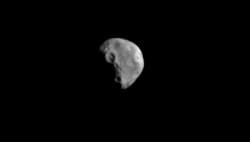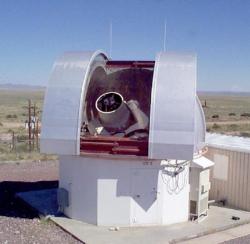On Tuesday, February 5, 2008 an SUV sized asteroid passed between the Earth and the moon. Asteroid 2008 CT1 came within 135,000 kilometers ( 84,000 miles) of Earth, only a third of the distance to the moon. The asteroid was discovered only two days before its close approach to Earth, spotted by the Lincoln Near Earth Asteroid Research (LINEAR) project, using robotic telescopes located at New Mexico’s White Sands Missile Range. The asteroid’s size is estimated between 8 – 15 meters.
While this asteroid seems small, we know that even small rocks can be devastating. Last September, a meteorite estimated at .2 – 2 meters wide created a crater 13 meters wide in Peru. The cause of the Tunguska Event of the early 20th Century is now believed to be a 35m rock that never even touched the ground. It’s believed that it exploded a few miles above the ground, creating a shockwave that devastated the landscape below.
2008 CT1 could possibly return to Earth’s vicinity in 2041, although its orbit has not yet been well defined, so that prediction could change. It is also a possible Mercury impactor, since that that planet is very near the asteroid’s currently calculated perihelion.
LINEAR uses a Ground-based Electro-Optical Deep Space Surveillance (GEODSS) telescope, and has detected over 3,000,000 asteroids since 1998, which is about 70% of the known near-Earth asteroids.
Original News Source: SLOOH Skylog



Asteroids can be devastating. Thats why Rep Rohrabacher has put forth the NEO Preparedness act. I posted the text of the bill as well as links to the committee members in congress who are considering the bill. It is being deliberated in the committee this week!
Be sure to read the bill at my site and contact you legislator (who I have also listed) so that you can weigh in on this important issue.
1/3 the distance of the moon..
thats what i call close.
SUV sized? What kind of MPG does that thing get?
BTW SUV sized doesnt = dangerous, it = would have been great to see that thing burn up.
Also, 24 – 45 feet DIA is not an SUV, it is a large truck.
Interesting story but Feb 4th was Monday not Tuesday
Cheers
Thanks, Big Ian for catching the error. It’s been corrected.
Nancy
I’d bet that asteroid gets about 3,000 MPG. I wish I could go 17,000 MPH!
On a serious note, that is staggeringly close. Imagine if that thing was maybe twice or three times the size and on target to hit our blue and green rock. 2 days is a very small margin. I’m sure that’s directly attributed to the fact that it was a relatively small object.
I just went out and measured two SUVs. Mine measures 24 ft. and my neighbor’s 26. I would say that SUV is a reasonable term.
In my limited experience, asteroids typically end up being smaller rather than larger, thus I would much rather an author understate with a smaller comparison than sensationalize with the largest.
If you read the entire article, it specifically notes that, contrary to usual thought, scientists are now learning that, given the right circumstances, even the smaller rocks can pose serious threats. I certainly would not call the recent Peruvian impact “not dangerous.” That 13m crater could have just as easily been in the middle of a school building. That was created by a .2m-2m rock .. a very small object.
Thank you to Action for Space for noting the proposed NEO Preparedness Act. This is a very serious issue, especially considering that scientists are having to adjust that dangerous vs. not dangerous threshhold.
They discovered this 2 Days before it passed less than a 3rd the distance to the moon? Doesn’t that make anyone’s sphincter pucker just a bit?
albiet it was an SUV size, no big deal unless it hit a major city or right off the coast to make a very big wave…
Its important to note here that as the search for dangerous asteroids becomes more mature, and the tools and techniques get better, and the power/efficiency of CCD cameras improves: We are find smaller and smaller asteroids.
I think the record for the smallest found is about 4 Meters wide now. Something that small hits the atmosphere every few years. So its only a matter of time now before our hard working astronomers pick up an incoming “boggie”.
I don’t think people appreciate how much work has gone into the approach and how refined the system has become in these past few years. It will never catch everything, but the process of the hunt, the governance and the credibility of the process used is a great achievement and a credit to all involved.
At least we have a credible process to assist manage the innevitable, the public response to it and the media’s sensationalism of it.
if the meteor that hit peru was 2m and caused a crater 15m wide then this one could have caused a crater up to 100m wide if it had hit… thats a mighty big hole… and we arnt worried???? maybe it would be beter to have only a couple of days warning and get it all over with rather than a few months or years?
the dangers that our earth is continually exposed to allien large rocks highlights once again the need to be prepared and to take actions to prevent these cataclysmic events yet this asteroid was able to skim the planet undetected our technology should be more directed i believe towards being prepared and able to take counter action against these hazards and less against fighting wars amongst ourselves.
The picture of Dactyl, Ida’s tiny moon, is a tactic the major TV news networks use. A picture unrelated to the story. An illustration of this tiny rock would have been better idea.
Just a back of a fag-packet calculation :-
From NEO website – Diameter 8.2 to18 metres – Call it 13m. Relative velocity =13.98 Km/Sec.
Typical rock density = 2.5 tonnes/m^3.
So mass of rock = 3300 tonnes.
That makes the energy on impact around the equavalent of 7700 tons of TNT.
Ouch!
Whoops – Typo.
That should be 77,000 tons of TNT.
http://www.focus.de/wissen/wissenschaft/faszination-wissen_did_16884.html
Is this a piece from TU24? Why in subtropical China Snow and Icestorms happens? Why suddently a meteriod in Antarktis is found? I think, this looks not weathered with the sharp edges!
So this is what I saw? Around 6PM PST? Right? If so, the sun had just about set, and while driving down the 405 w/ no stars out yet, in the Southern sky, I saw a HUGE, slowish moving “shooting star.” Amazing.
Yeah, uh, I doubt that. The only way the “shooting star” phenomenon can take place is for a rock or other object to be slamming into the atmosphere with intense friction and g-forces. This asteroid was a third of the distance to the moon away from the planet. You probably saw a plane, David.
I don’t understand it, I’m a star gazer and I knew instantly when I looked up that that “fuzzy spot” did not belong where I was seeing it. If I had not happened to catch a small article in the paper a few days later about a near earth asteroid I would have convinced myself I was seeing things. How can an asteroid so close it looks like a comet be blown off like it was nothing? It was beautiful, and ignored. I did not happen to note the exact weekend that I saw this, but am amazed that there is not more about the siting, it was as beautiful as the last comet that went by. Where are the pictures?